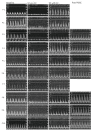Evaluation of coronary blood flow velocity during cardiac arrest with circulation maintained through mechanical chest compressions in a porcine model
- PMID: 22182425
- PMCID: PMC3297515
- DOI: 10.1186/1471-2261-11-73
Evaluation of coronary blood flow velocity during cardiac arrest with circulation maintained through mechanical chest compressions in a porcine model
Abstract
Background: Mechanical chest compressions (CCs) have been shown capable of maintaining circulation in humans suffering cardiac arrest for extensive periods of time. Reports have documented a visually normalized coronary blood flow during angiography in such cases (TIMI III flow), but it has never been actually measured. Only indirect measurements of the coronary circulation during cardiac arrest with on-going mechanical CCs have been performed previously through measurement of the coronary perfusion pressure (CPP). In this study our aim was to correlate average peak coronary flow velocity (APV) to CPP during mechanical CCs.
Methods: In a closed chest porcine model, cardiac arrest was established through electrically induced ventricular fibrillation (VF) in eleven pigs. After one minute, mechanical chest compressions were initiated and then maintained for 10 minutes upon which the pigs were defibrillated. Measurements of coronary blood flow in the left anterior descending artery were made at baseline and during VF with a catheter based Doppler flow fire measuring APV. Furthermore measurements of central (thoracic) venous and arterial pressures were also made in order to calculate the theoretical CPP.
Results: Average peak coronary flow velocity was significantly higher compared to baseline during mechanical chests compressions and this was observed during the entire period of mechanical chest compressions (12 - 39% above baseline). The APV slowly declined during the 10 min period of mechanical chest compressions, but was still higher than baseline at the end of mechanical chest compressions. CPP was simultaneously maintained at > 20 mmHg during the 10 minute episode of cardiac arrest.
Conclusion: Our study showed good correlation between CPP and APV which was highly significant, during cardiac arrest with on-going mechanical CCs in a closed chest porcine model. In addition APV was even higher during mechanical CCs compared to baseline. Mechanical CCs can, at minimum, re-establish coronary blood flow in non-diseased coronary arteries during cardiac arrest.
Figures




Similar articles
-
Cardiac Arrest in the Cardiac Catheterization Laboratory: Combining Mechanical Chest Compressions and Percutaneous LV Assistance.JACC Cardiovasc Interv. 2019 Sep 23;12(18):1840-1849. doi: 10.1016/j.jcin.2019.05.016. JACC Cardiovasc Interv. 2019. PMID: 31537284
-
Adverse hemodynamic effects of interrupting chest compressions for rescue breathing during cardiopulmonary resuscitation for ventricular fibrillation cardiac arrest.Circulation. 2001 Nov 13;104(20):2465-70. doi: 10.1161/hc4501.098926. Circulation. 2001. PMID: 11705826
-
The effects of epinephrine/norepinephrine on end-tidal carbon dioxide concentration, coronary perfusion pressure and pulmonary arterial blood flow during cardiopulmonary resuscitation.Resuscitation. 2000 Jan;43(2):129-40. doi: 10.1016/s0300-9572(99)00129-x. Resuscitation. 2000. PMID: 10694173
-
Mechanical versus manual chest compressions for cardiac arrest.Cochrane Database Syst Rev. 2018 Aug 20;8(8):CD007260. doi: 10.1002/14651858.CD007260.pub4. Cochrane Database Syst Rev. 2018. PMID: 30125048 Free PMC article.
-
Haemodynamics of cardiac arrest and resuscitation.Curr Opin Crit Care. 2006 Jun;12(3):198-203. doi: 10.1097/01.ccx.0000224861.70958.59. Curr Opin Crit Care. 2006. PMID: 16672776 Review.
Cited by
-
Cardiopulmonary resuscitation using electrically driven devices: a review.J Thorac Dis. 2015 Oct;7(10):E459-67. doi: 10.3978/j.issn.2072-1439.2015.10.40. J Thorac Dis. 2015. PMID: 26623121 Free PMC article. Review.
-
Improving survival from mechanical chest compression resuscitation.Resusc Plus. 2022 Sep 15;11:100285. doi: 10.1016/j.resplu.2022.100285. eCollection 2022 Sep. Resusc Plus. 2022. PMID: 36164473 Free PMC article. No abstract available.
-
Corpuls CPR Generates Higher Mean Arterial Pressure Than LUCAS II in a Pig Model of Cardiac Arrest.Biomed Res Int. 2017;2017:5470406. doi: 10.1155/2017/5470406. Epub 2017 Dec 17. Biomed Res Int. 2017. PMID: 29392137 Free PMC article.
-
Repeated epinephrine doses during prolonged cardiopulmonary resuscitation have limited effects on myocardial blood flow: a randomized porcine study.BMC Cardiovasc Disord. 2014 Dec 20;14:199. doi: 10.1186/1471-2261-14-199. BMC Cardiovasc Disord. 2014. PMID: 25528598 Free PMC article.
-
Unexpected collateral impact after out of hospital resuscitation using LUCAS system.J Cardiothorac Surg. 2017 Sep 7;12(1):81. doi: 10.1186/s13019-017-0643-z. J Cardiothorac Surg. 2017. PMID: 28882147 Free PMC article.
References
-
- Larsen AI, Hjornevik A, Bonarjee V, Barvik S, Melberg T, Nilsen DW. Coronary blood flow and perfusion pressure during coronary angiography in patients with ongoing mechanical chest compression: a report on 6 cases. Resuscitation. 2010;81(4):493–497. doi: 10.1016/j.resuscitation.2010.02.002. - DOI - PubMed
-
- Wagner H, Terkelsen CJ, Friberg H, Harnek J, Kern K, Lassen JF, Olivecrona GK. Cardiac arrest in the catheterisation laboratory: a 5-year experience of using mechanical chest compressions to facilitate PCI during prolonged resuscitation efforts. Resuscitation. 2010;81(4):383–387. doi: 10.1016/j.resuscitation.2009.11.006. - DOI - PubMed
-
- Bonnemeier H, Olivecrona G, Simonis G, Gotberg M, Weitz G, Iblher P, Gerling I, Schunkert H. Automated continuous chest compression for in-hospital cardiopulmonary resuscitation of patients with pulseless electrical activity: a report of five cases. Int J Cardiol. 2009;136(2):e39–50. doi: 10.1016/j.ijcard.2008.04.095. - DOI - PubMed
Publication types
MeSH terms
LinkOut - more resources
Full Text Sources
Medical

